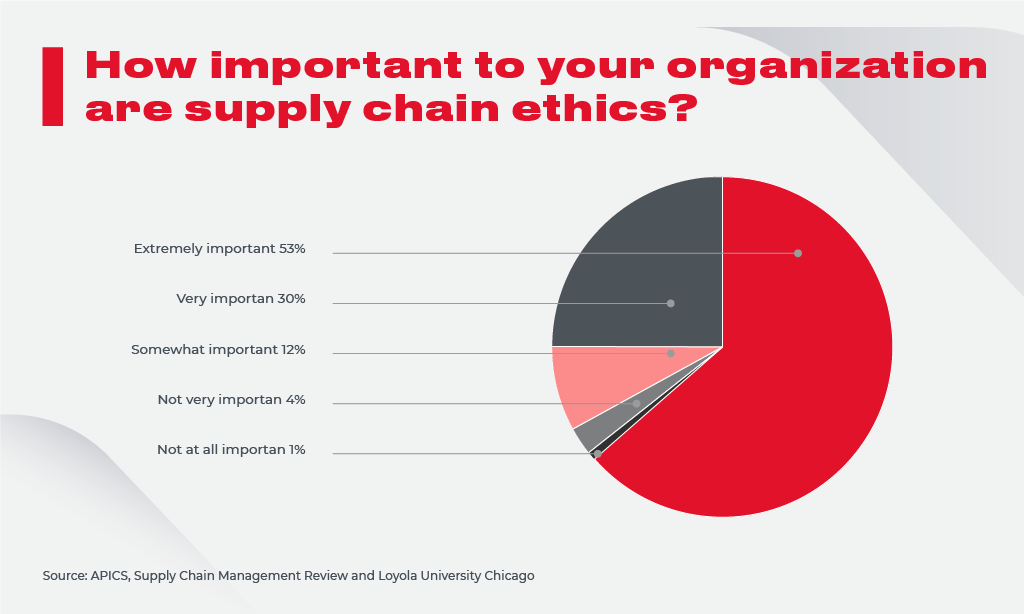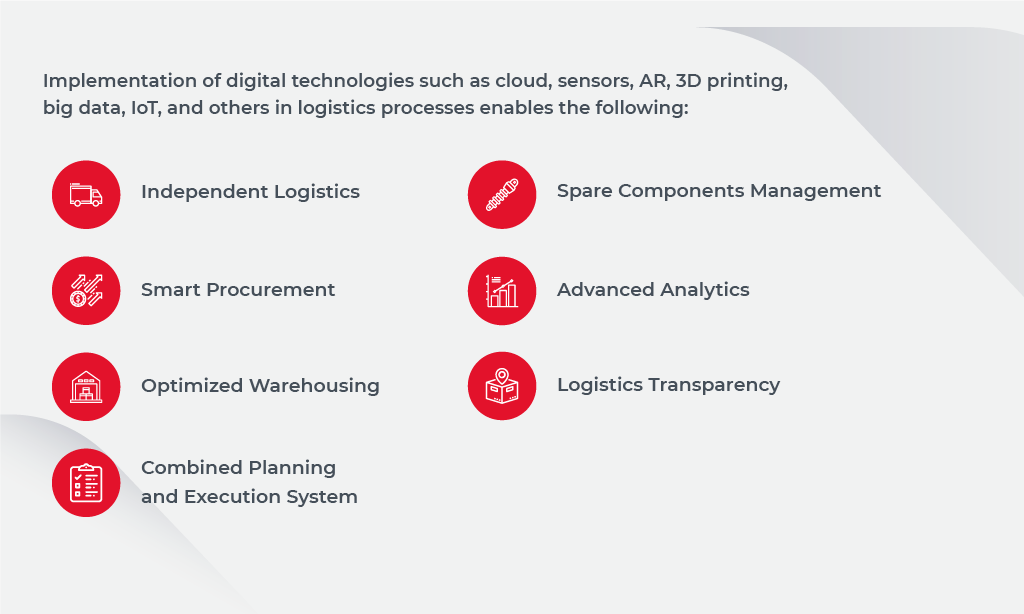How Digitalization Makes Green Supply Chain Achievable
The fast-paced digitalization provoked by Industry 4.0 has modified the business, creating an extremely changing market. Now, the main focus of Industry 4.0 is to implement tech solutions so that the business and development processes run side by side to make manufacturing and logistics resilient, cost-effective, green, and high quality.
The research from APICS, Supply Chain Management Review and Loyola University Chicago finds out that operating a responsible supply chain is an increasing priority for 83% of surveyed.

Thus, the companies need to find balance in their growth, profitability and green efforts as the demand drives business to supply chain sustainability.
Digitalization in Terms of Green Supply Chain
The future of green supply chains is determined by digitalization, as it helps to build a reliable and green transportation system and supply of goods. Therefore, logistics companies have begun to adopt smart and connected tools and applications such as cloud, mobile, sensors, blockchain, BDA (big data analytics), ML (machine learning), and IoT.
“This has created a need for a new business paradigm toward a connected, smart, highly efficient and sustainable digital logistics ecosystem that is fully transparent to all the players involved – from the suppliers of raw materials, components, and parts, to the transporters of those supplies and finished goods, and finally to the customers demanding fulfillment.”, – states the recent research on the sustainability impact of digitization in logistics.
With the digital revolution come endless opportunities to foster the growth of GSCM (green supply chain management) by decreasing logistics-related emissions by 10-12% by 2025, thereby decarbonizing the world’s economy.
Some companies have already taken actions in response to a growing need for global supply chain transformation. For example, DHL has made its mission to achieve zero emissions by 2050 and become the industry benchmark for responsible business practices.
FedEx is also going to decrease its footprint by lowering aircraft emissions 30%, increasing FedEx Express transport productivity by 30% by 2020, and getting 30% more alternative fuels by 2030. Also, FedEx strives to use less energy and more energy-efficient lighting.
The green digital logistics aims to redesign digital business models and business processes within the supply chain to sustainable engineering and balance sustainability considering economic, social, and environmental aspects with tight connections between them.

Digital Opens New Horizons for Green Supply Chain Management
Logistics designed with digital technologies (IoT, blockchain, cloud, mobile) offers significant advantages for managing, planning, and synchronizing cargo and shipping operations:
- real-time visibility during the entire supply chain
- high potential for better optimization using BDA
- device and location independent data collecting using cloud computing
- better automation through human-machine interaction
- intelligent user interface and software design for horizontal and vertical collaboration
- smooth management through decentralized and autonomous decision-making
- reducing errors in complex processes and creating a friendly customer experience using AR (augmented reality) tools such as wearable computing.
Thanks to these digital technologies, the companies can quickly react to disruptions in the supply chain, adapt to changes in logistics processes, and even foresee possible risks.

Benefits of Green Logistics from a Business Perspective
While the global goal of building a sustainable supply chain is to contribute to saving the environment by reducing GHG emissions, there are still benefits for boosting business itself.
Have a better reputation
Companies that decided to go green are guaranteed to get global recognition. Today, environment-friendly activities embrace more than recycling and reducing waste. The Corporate Knights’ overview of the 2019 Global 100 Most Sustainable Corporations states, green efforts cause a decrease in CO2 emissions and waste production, gender equality in leadership, and even gains from sanitary products.

Find new revenue streams
You can disregard many pathways to earn money from your green efforts. See below what GSCM offers:
- Since you became green, you can sell your tools for making the supply chain sustainable. These ready-to-use instruments will bring you gains while saving other companies’ time and money.
- Sell waste produced by your business. The sustainability trend forces organizations for recycling waste. So, you can help those companies to get raw materials while also having some makings from it.
Reduce energy costs
Traditional power sources will soon become outdated, as the adoption of renewable energy implies not only lower emissions and pollution but lower prices as well. For instance, using biofuels, solar power and wind energy.
The majority of companies are indifferent about keeping the planet safe unless it is beneficial to their earnings. But this pattern has drastically changed. The green supply chain strategy appeals to both environment-oriented and business-oriented executives and reveals to them endless opportunities.
Technologies That Make Supply Chains More Sustainable
New technologies such as Big Data and AI can positively influence the companies that aren’t sustainable yet. These tech solutions, for example, can help businesses gain profits from quick, affordable, and sustainable routes for product shipping and combining these seamlessly.
Use of AI and Big Data
Applying AI and innovative algorithms can drastically enhance the sustainability and effectiveness of supply chains by driving businesses to collaborate. There are three particular areas in which these technologies are applicable to create an intelligent, effective logistics chain.
Sharing shipping for endless opportunities
Sharing or collaborative shipping suggests the shared use of transportation methods between different parties. A special algorithm, developed at Vlerick Business School and KU Leuven, helps companies find more ways to share their shipping details, then join forces with other transporting providers.
This algorithm records pick-up and drop-off details of shipping firms using GPS data. Therefore, the system is aware of the conditions of shipping, load in stock, vehicle types, and the costs at all times. Using this AI-based solution allows organizations to share their supply chain details with other firms, expedite the logistics, save money, reduce pollution, thus making their supply much greener.
Better route planning with autonomous vehicles
The most popular AI application in logistics is the development of autonomous transports. With advanced GPS tools, driverless cars can plan and follow more beneficial routes than humans. For example, electric self-driving boats and driverless semi-trucks are already available, so the future of green logistics is exciting.
Planning the urgency of deliveries
Another task AI can do very well is to maximize shipping efficiency by determining the necessity of shipments. AI can monitor the shipping environment to create delivery routes that balance package urgency with fuel efficiency. Besides, AI can adapt to fluctuations in particular deliveries’ priority after they leave the warehouse, thanks to making complex calculations much faster than people do.
Making complex decisions faster
Companies using DRL (deep reinforcement learning) can train AI to make complex and positive decisions in favor of the green supply chain. For instance, AI can define the precise number of goods to ship, when to ship and which type of vehicle to use. Because AI-based systems work in real-time, they can adapt to changes as problems occur, minimizing different associated risks.
Also, smart tools can analyze how a supply chain works, then suggest insights on how to improve it. Companies can leverage AI tools to ensure they only work with sustainable partners.
Use of IoT
More than 67% of organizations operating with industrial IoT solutions saw improvements in environmental sustainability, as they revealed in the 2018 survey. However, significant changes won’t happen at once. It will take time, money, and strong efforts.
Becoming more fuel-efficient
The transportation of goods with over 13% is one of the biggest contributors to global GHG emissions. Using smart IoT tech can help in reducing this terrific impact. The Internet of Things is applied to find better planning routes and ship stocks directly where there’s a market for them, which in turn leads to a significant drop in gasoline and diesel consumption.

Reducing the waste of goods
The IoT tech allows companies to monitor and record the conditions of the goods within containers. If identified, damaged or near-expire products can be immediately reshipped for replacement. This can reduce the demand for reverse logistics practices as consumers will rarely find the reason to return products.
One of the largest manufacturers of tires, Pirelli, has incorporated autonomous electronic sensors to its warehouses to track the location of tires, their accurate number, and the number of new items to set in production. With customized manufacturing, Pirelli can avoid discarding tires in landfills and minimize the release of toxins into the atmosphere after tires break down.
Effective management of urban infrastructure
Cities worldwide have started to embrace IoT systems to run civic infrastructure more environment-friendly. Barcelona has deployed internet-connected technology to manage city lighting. Thus, through the use of sensors and LEDs, Barcelona has lowered the energy consumption used for public lighting. Also, these lampposts can capture data on pollution, humidity, temperature, noise, and the presence of people as well as provide the free WiFi network across the entire city.
Conclusion: Build Green Supply Chain Management with Innovecs
We know that sustainable supply chain management drives efficiency and is increasingly seen as a top priority for organizations to achieve in the next decade. Sustainable logistics practices will help you drive positive business change by:
- Improving the overall company image
- Substantial savings with energy alone
- Generating new revenue streams
- Becoming eco-friendly
- Finding new partners
- Expediting many logistics processes
Whether you are on the way of building a robust green supply chain management platform or need to reshape an existing one within your company to make it more sustainable, we at Innovecs are ready to offer top-notch logistics software solutions.